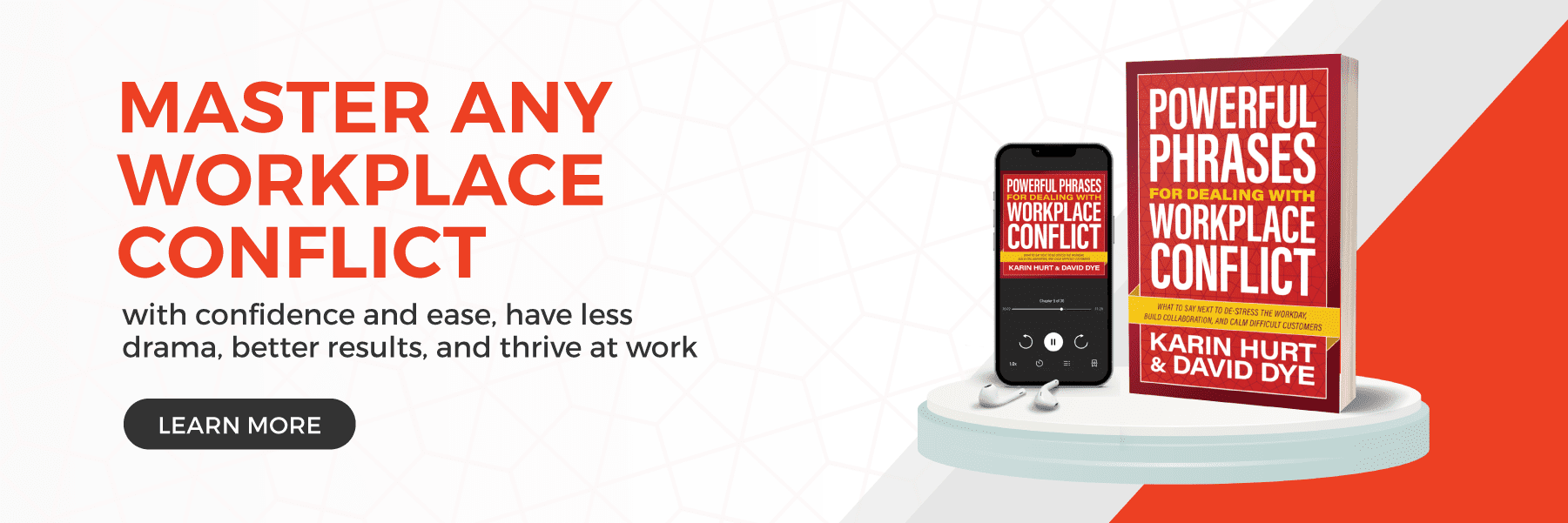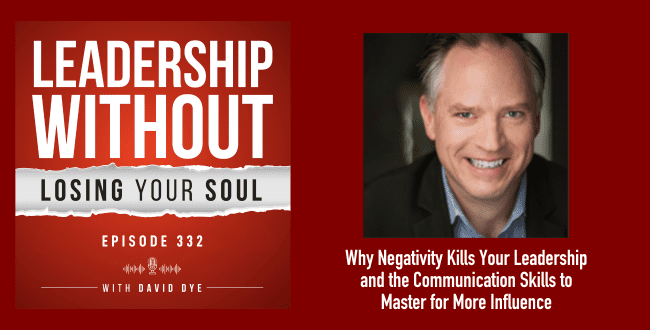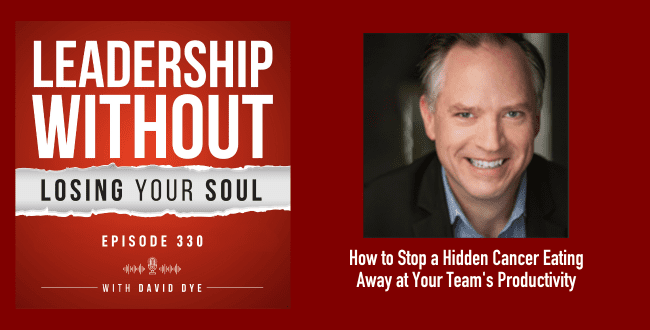How do we solve the right problem quickly and get ourselves and our team back to work? When someone walks up to you and says, can I talk to you for a minute? We’ve got a problem. How do you respond? When people are confronted with problems, a lot of times you get one or two reactions from managers. In this episode, David uses a real-life situation to walk through the steps of how we take responsibility for solving problems, solving the right problems, determining the best person to own the problem, and working to resolve it.
Help Your Team Solve the Right Problem
00:54
How do we solve the right problem quickly and get ourselves and our team back to work? When people are confronted with problems, a lot of times you get one or two reactions from managers. They’ll get frustrated and lash out at their people or run back and forth searching for answers that are going to get their boss, customer, or employee off their back.
01:40
Of course, neither of those is productive. So what are we after? How are we going to take responsibility for solving problems, solving the right problems, determining the best person to own the problem, and working to resolve it? I want to give you a quick example when we talk about solving the right problems. Poncha was a respected nurse manager who treated her staff well, ran an efficient unit, and was good with patients, but her staff was upset because patient satisfaction scores had declined over the past two months. So Poncha does a little digging. Tracked down what was a relatively minor issue. Patients were cold and Frank, the manager responsible for inventory and equipment wasn’t getting the blankets washed and distributed every morning. This was clearly a part of his job description. But when Poncho spoke with him about it, she discovered that the surgery center administrator, Don, whom they both reported to, had given Frank other priorities for his early morning work.
02:43
Frank was a pleaser manager type and didn’t want to question his boss. So now Poncha and her employees were being held accountable for the consequences of a problem they could not solve directly. Does this sound familiar? Everybody runs into these kinds of situations and there are these kinds of inefficiencies and the potential conflicts that happen in every organization. A decision by one person affects the results and the welfare of employees in other areas in unforeseen ways. It’s a reality of organizational life and it can frustrate even the most common and unflappable managers. So in this case, Poncha let Frank know that she would be speaking with Don and invited him to come along. When they had the conversation, Poncha framed the issue in terms that resonated with Don. She said we have an issue that can negatively impact revenue by five to 10% over the next six months.
03:43
Once she captured Don’s attention with something that he cared about, she was able to explain the situation and propose solutions. Don agreed, Frank was happy to do what he was told to do and the patients got their blankets. I want to break this down a little bit in terms of this being a real-life situation, changed Poncha’s name, but the situation actually happened and there was some coaching along the way. So a real real-life situation, Poncha demonstrated this problem-solving principle of taking responsibility without owning other people’s problems. When you take responsibility, you ask, how can I make this better? Then determine who actually owns the problem. In this case, Frank could have owned the problem, but it wasn’t Poncha’s job to change Frank. She didn’t own someone else’s problem when she asked herself, how can I make this better?
04:35
It was clear that she needed to talk to Don. She took responsibility, located the problem with its proper owner phrased the problem in terms that were meaningful to the person who owned it, and then shared possible solutions. So it’s a good way to approach these things in terms of how you take responsibility, how you own a problem without taking responsibility for someone else’s problem. Asking that question, how can I make this better than finding the real owner now? So that’s finding the real owner and taking responsibility. Now let’s talk about finding the real problem because it’s very common for managers will waste tons and tons of time in these vain attempts to solve the wrong problem. So part of the key is when you’re first presented with a problem, you don’t just want to jump right in and reactively try to go to solutions right away.
05:30
You want to pause, ask questions, and then figure out the real issue. So imagine if when Poncha first heard that her nurses were upset and she immediately responded the way that many managers do saying something like, satisfaction scores are down. Alright, let’s work on that. Move faster, and be nicer. Her solution would frustrate her staff and mask the actual problem. Scores might even briefly improve, but they wouldn’t be sustainable. And then that would exacerbate everything. So when you’re presented with a problem, avoid the inclination to react immediately when what people bring you is likely a symptom of the problem, not the problem itself. So pause, get curious, ask questions, and get all the relevant facts. Here are some specific questions you can ask to solve the right problem and not waste your time, which you don’t have enough of, to begin with addressing symptoms.
06:28
The first question is, what is different than expected? And I learned this from an old book, but really good book called The Rational Manager by Charles Kepner and Benjamin Trigo. They define a problem as a deviation from some standard of performance. Okay, there’s a way we expect things to be, there’s a deviation from that. We’ve got a problem. What didn’t go the way you expected? So when Poncha asked what was different than expected, it was obvious that the overall patient satisfaction scores were lower than they had expected. Alright? So that’s what’s changed. Second question, what has not changed? And this is a critical step that most managers will skip altogether. When you identify a problem, it’s helpful to know what has not changed. This helps you eliminate issues that you don’t need to concern yourself with. For example, when Poncha understood the scores had dropped, she asked which scores.
07:29
Is it all of them or just a few? As she examined all the data, it was clear that most of the scores had held steady and just those around comfort had changed. This helped her narrow her problem-solving. The issue wasn’t speed or quality of care, but comfort. And then question three, why? Once you’ve limited the problem to what it is and what it is not, then you look for causes by asking why. And yes, you’ll often have to ask several times. So Poncha asked, why patient comfort scores declined over the past two months. When she asked her staff for their thoughts, no one could come up with an answer that fit the problem, changes that only impacted comfort and occurred only in the past two months. From there, she pulled the patient surveys for the previous four months and examined every form that rated comfort as average or below and discovered that in the two months prior to the drop, low comfort scores had a wide range of issues, all with low frequency.
08:32
But starting two months ago, 50% of the low comfort scores mentioned coldness or the lack of a blanket. Now, she had a lead notice that she still didn’t know the actual problem. What she discovered was a symptom. Patients weren’t receiving blankets. She had to ask why. Again, in order to figure out that Frank wasn’t supplying them the way he used to, she had to ask why one more time to determine that Don had given Frank competing priorities and that Frank wasn’t willing to speak up about it himself. Only at that point did Poncha find the real problem.
09:09
So now you’ve identified the real problem. You’ve taken responsibility, you’ve taken ownership, you’ve figured out what the real problem is. Now you’ve got another choice to make bu asking yourself is this the right problem to solve? Because not every problem needs a solution. And so again, resist the urge. One of those push-pause moments as a leader here resists the urge to immediately jump in with solutions. You can do some quick analysis and figure out whether or not you should spend any more time on it at all. So what do I mean by this? Well, just some quick back-of-the-napkin kind of math here. When you’re looking at problems, the first question you want to ask is, how likely is this problem to occur in the future if it’s an unlikely event that no amount of planning could have changed?
09:59
Or is it something that is clearly 100% going to happen again? So if you had to put a percentage chance on the probability that the problem will happen again in the next week or quarter or a year, what is that probability? So for Poncha, it’s a hundred percent. If nothing changes, it’s a hundred percent that patients are going to continue to be cold. Question two, what’s the magnitude of the damage if the problem does happen again? You can start with a qualitative type of measure. If the problem happens again, what’s the impact on your group or the organization? Negligible, not good, bad, very bad, or disastrous. So you can try to quantify the label you use. So if you say bad, for example, what does that mean in terms of your metrics, money, time, people, customer, client impact, and so on? So once you know the likelihood that the problem will recur and the magnitude of the impact when it does multiply the two.
10:56
For instance, Poncha had determined the problem was 100% likely to happen again, and the impact was bad to the tune of five to 10% lost revenue over the next six months. And that would only get worse as the problem continued. So that’s the math that she shared with Dawn and looking at their revenue and applying that against, she came up, this is a 7.57 and a half million dollars potential problem over the course of six months. Well, that’s significant. Dawn decided that math made sense to address, they’re going to address it. And then the third question is, you’re looking if the problem really is something that you can directly address or not, then you got to figure out is it best to prevent the problem or to mitigate the impact of the problem.
11:47
In this instance, let’s say that the problem was that patients were cold, right? They could have mitigated the impact of the problem by maybe having staff call the patients and apologize for the lack of blankets, but that’s not going to be sufficient. So mitigating in this case wouldn’t make sense. Another approach, maybe they could have turned up the heat, but that has consequences too. So it’s going to cost more. You’re going to make other patients uncomfortable. It reduces the customization. So you have choices to make here. The only solution possible was not only that, Frank does more blankets, but there are a number of different options. So is it best to prevent the problem? In this case, they said yes, it’s going to make more sense to solve the problem and reassign priorities to free up Frank for blanket duty. This is an easy example that as you’re looking at problems, take a look at how you can take responsibility, figure out the real problem, and then decide whether or not it needs a solution. And if that solution is preventing or mitigating the problem itself. And this kind of just taking a moment, taking a beat to sit there and think through these three categories, these three questions will help you and your team solve the right problems quickly, make the biggest difference for yourself, your results, and ultimately get back to work.
13:15
As we wrap up this episode, I want to thank Poncha again for bringing this workplace challenge to our attention and looking for help as she was figuring out how to approach it, and how to deal with it, we all are able to learn and grow with Poncha. So thank you, Poncha. Appreciate your leadership in this situation. And listeners, figure out how you can take responsibility. What is the right problem to solve? What does the successful resolution of that problem look like? Does it need to be solved? Can it be mitigated? Do you need to bother? Or is it such a low likelihood or a low impact that you can just ignore it? Sometimes that’s the right answer. So take responsibility, define the real problem, figure out the solution, and be the leader you’d want your boss to be.









0 Comments